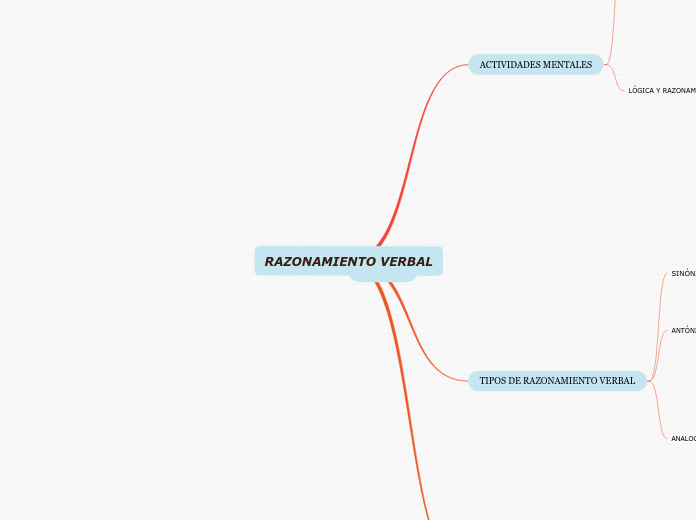RAZONAMIENTO VERBAL
ACTIVIDADES MENTALES
CONEXIÓN DE IDEAS
Léxico amplio
Conocer vocabulario
Saber utilizar el vocabulario
Aplicar reglas para un adecuado uso
LÓGICA Y RAZONAMIENTO
Emplear palabras con propiedad
Lógicamente
Ordenadamente
Fomenta la capacidad de
Abstracción
Sistematización
Subtopic
Síntesis
Extiende
Cultura general
Conocimientos
Desarrolla mentalidad
Crítica
Reflexiva
Subtopic
Creativa
Mejora
Comprensión lectora
Argumentación
Análisis de situaciones
Procesamiento de textos
TIPOS DE RAZONAMIENTO VERBAL
SINÓNIMOS
Palabras con el mismo significado y diferente escritura
abundante - mucho
alterado - nervioso
apto - hábil
Enriquece el vocabulario
ANTÓNIMOS
Significado opuesto o inverso al de otra palabra
Facilitan el entender una palabra si se comprende lo que significa su contrario
ANALOGÍAS VERBALES
Dos pares de palabras que se relacionan
Arma es a guerra como argumento a debate
Capitán es a barco como alcalde es a ciudad
El reloj es al tiempo como el termómetro al calor
Relación de semejanza entre cosas distintas
Tipos de analogías
De complementariedad
De ubicación
Por intensidad
De género - especie
Causa y efecto
Secuencia
COMO DESARROLLAR EL RAZONAMIENTO VERBAL
Aumentar léxico
Vocabulario de un idioma
Capacidad de razonamiento
Establecer relación entre distintas palabras
Realizar lecturas y buscar en el diccionario palabras que no entendemos su significado
Resolver autodefinidos
Buscar asociaciones de sustantivos individuales
